EMERGENCY LIGHTING FROM THE KITCHEN! WHO KNEW?
Did you know that you could create emergency lighting from a food that you likely have in your kitchen this very day? I’m talking about olive oil! I first read about this several years ago in Mother Earth News. Written by Deanna Duke, this very helpful information (paraphrased below), is all about making olive oil lamps.
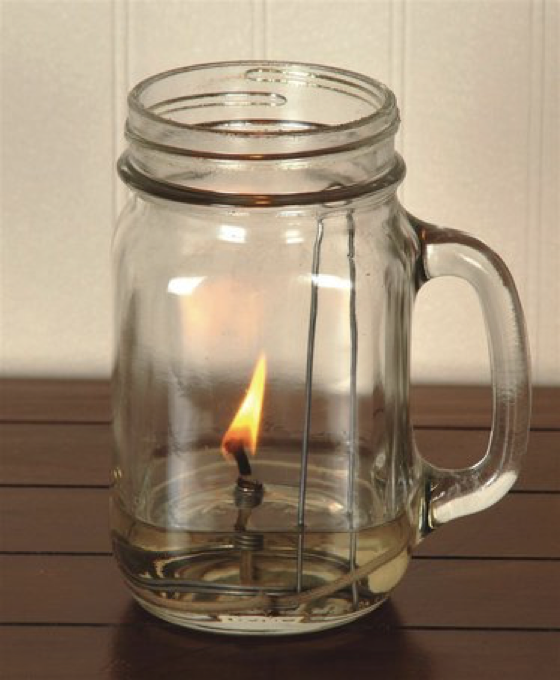
This seems timely, considering the increased frequency of power outages due to hurricanes, high winds and other storms that the country’s been experiencing the past year or so. We’re finding that having back-up lighting on hand is a necessity. While candles are a sure bet, they don’t offer much light, they can be messy, and beeswax and soy candles can get expensive.
And there are drawbacks to hand-crank and battery-powered lanterns, as well as kerosene or propane lamps as well. So, olive oil is a better option for several reasons: materials are easy to acquire, inexpensive, and gentle on the environment; they burn bright and long; and if the lamp gets knocked over, it stops burning because it has a high flash point (it’s not a very flammable material). Also, unlike kerosene, olive oil doesn’t stink as it burns. As a result, an olive oil lamp is just an all-around good choice for non-electric emergency lighting.

And if you don’t care to use your pure, more expensive olive oil, this would be a good use for any adulterated olive oil you may have on hand (see “Olive Oil: You Want the Real Deal!” Aug, 2020 Cook’n Newsletter). This is such a good idea, because olive is a renewable fuel that won’t produce smoke or give off an odor.
The author does say that you can use other types of cooking oil, liquid fat or grease, but she doesn’t vouch for vegetable oils as being smoke-free or that they won’t make the house smell like burnt popcorn.
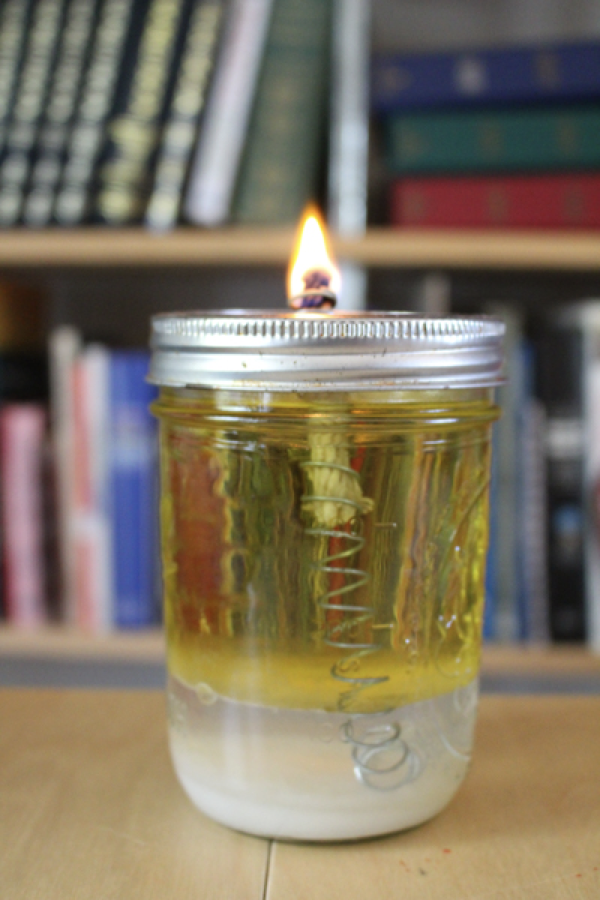
Making your lamp is relatively simple, and you’ll likely have many of the materials on hand already:
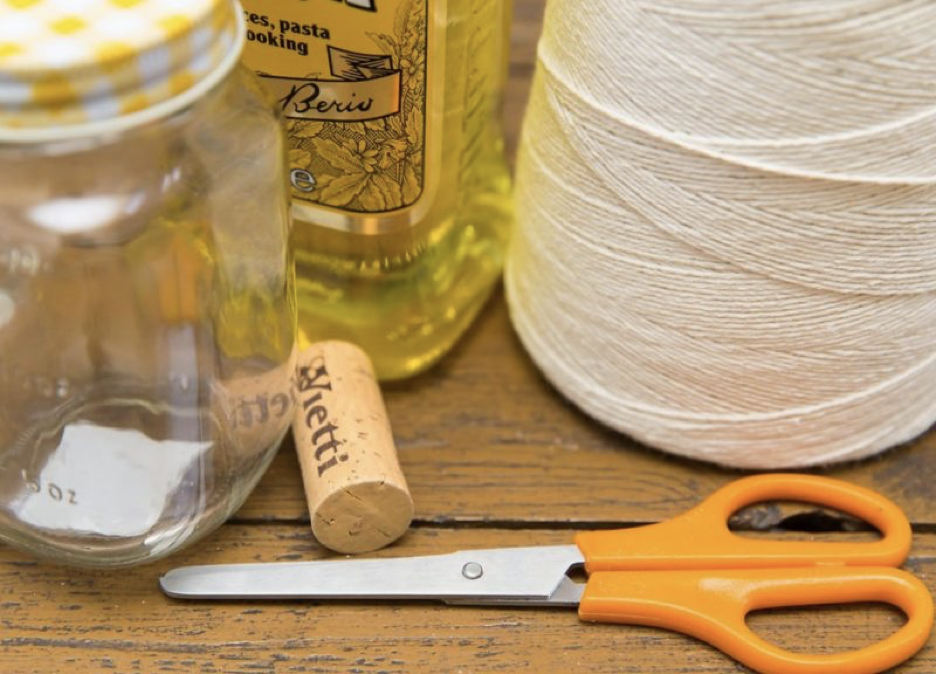
By using a canning jar, you can close the jar for storage with a canning lid, when the lamp is not in use. Various sizes of jars will work just fine by adjusting the size of the wick holder to fit the size of the jar. And author Duke used a canning jar lid with a hole punched in it to hold the wick instead of a wire coil to ensure the oil didn’t spill.
Also, any (non-plastic) container can be turned into an oil lamp. Shoot, you can even use the bottle your olive oil came in! In ancient times empty sea shells or even rocks with a slight indentation were used for this purpose. And actually, any natural fiber can be used as a wick.
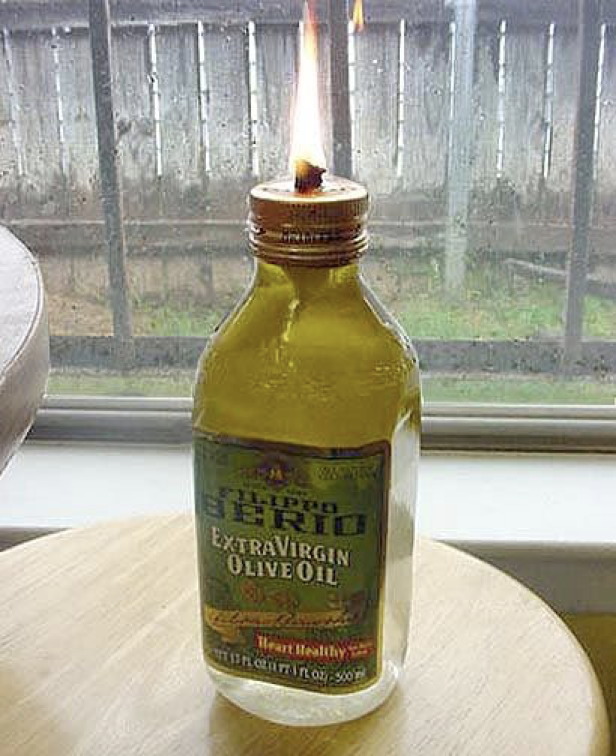
The lamp works by drawing the olive oil up the wick, where it vaporizes and gets burned by the flame. A few ounces of oil will burn for several hours, making it less expensive than most candles. And if you have problems with it smoking when blowing it out, use wet fingers to put out the flame, or just douse it with the oil in the jar.
If you’d like to fancy things up, you can infuse your olive oil with herbs, spices, essential oils, or citrus slices for a more scented experience.
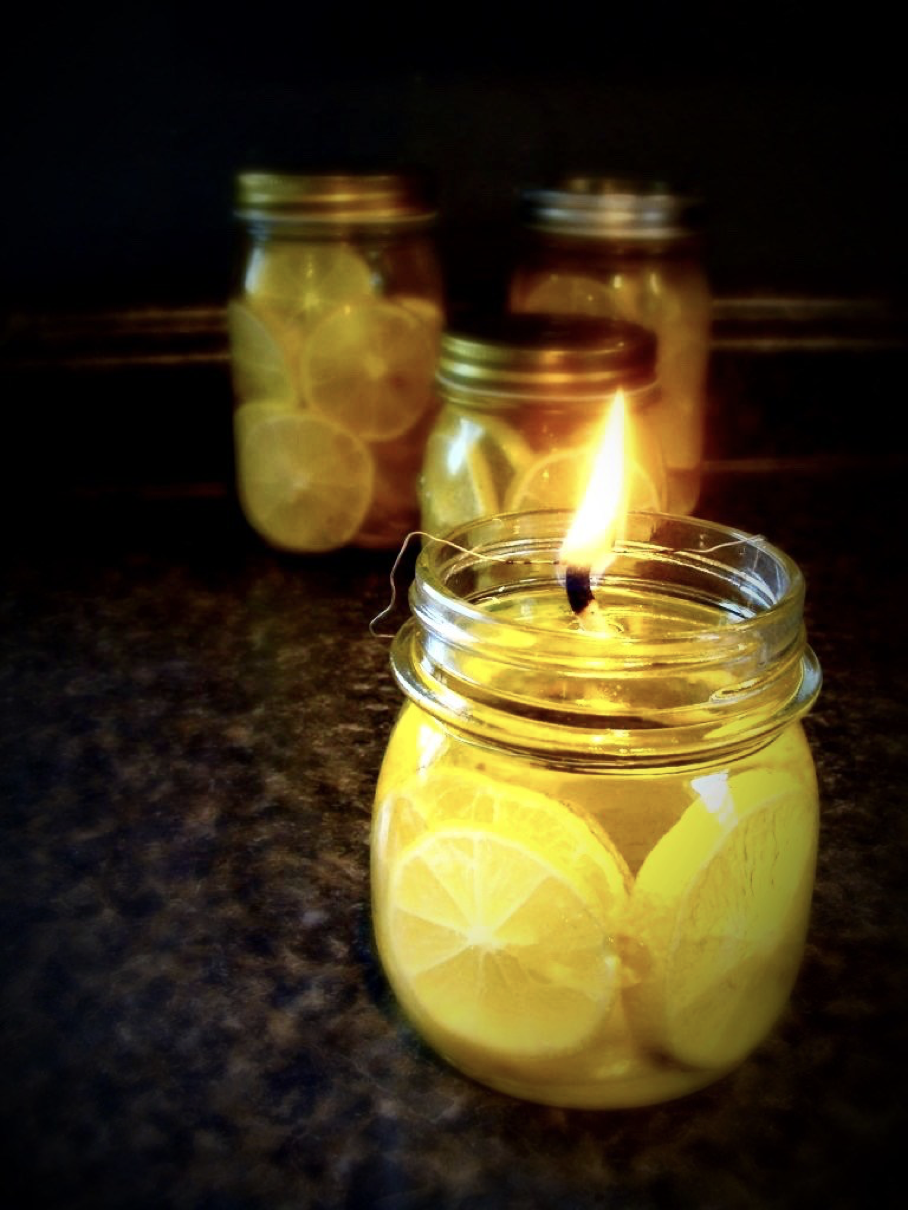
And speaking of fancy, another clever person created an olive oil lamp chandelier out of a discarded lamp shade frame. I didn’t find instructions on how to secure the jars to the shade base, but I bet we could figure it out!
Finally, you might want to get the little book, BOOK 2: OLIVE OIL LAMPS & ETC. (The Non-Electric Lighting Series) by Ron Brown. I found it on amazon.com for about $7. Besides olive oil, Brown also explains how to use other food grade oils, cotton puffs, and so on (which is why ETC is in his title).
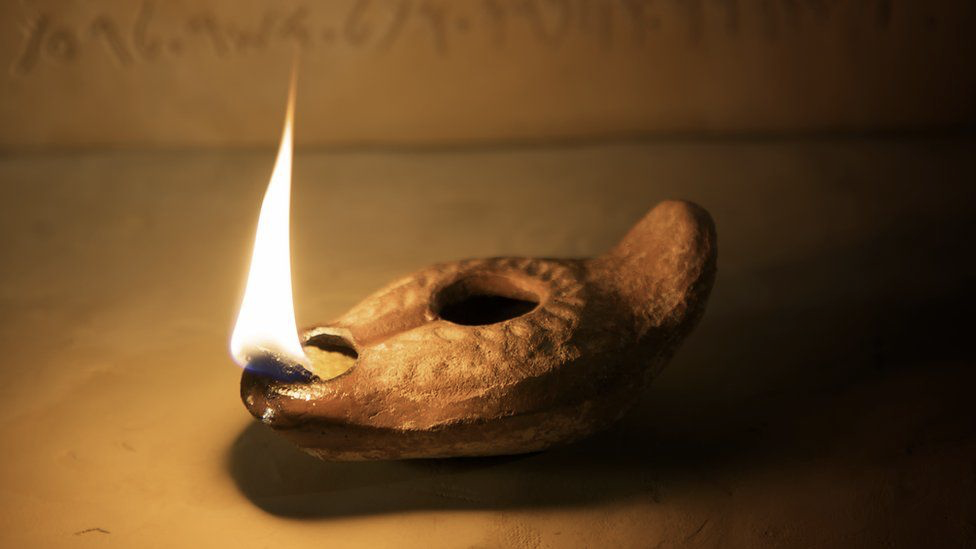
The olive oil lamp has been around since Biblical times. Think of it as proven technology. Emergency lighting from your kitchen—who knew?

This seems timely, considering the increased frequency of power outages due to hurricanes, high winds and other storms that the country’s been experiencing the past year or so. We’re finding that having back-up lighting on hand is a necessity. While candles are a sure bet, they don’t offer much light, they can be messy, and beeswax and soy candles can get expensive.
And there are drawbacks to hand-crank and battery-powered lanterns, as well as kerosene or propane lamps as well. So, olive oil is a better option for several reasons: materials are easy to acquire, inexpensive, and gentle on the environment; they burn bright and long; and if the lamp gets knocked over, it stops burning because it has a high flash point (it’s not a very flammable material). Also, unlike kerosene, olive oil doesn’t stink as it burns. As a result, an olive oil lamp is just an all-around good choice for non-electric emergency lighting.

And if you don’t care to use your pure, more expensive olive oil, this would be a good use for any adulterated olive oil you may have on hand (see “Olive Oil: You Want the Real Deal!” Aug, 2020 Cook’n Newsletter). This is such a good idea, because olive is a renewable fuel that won’t produce smoke or give off an odor.
The author does say that you can use other types of cooking oil, liquid fat or grease, but she doesn’t vouch for vegetable oils as being smoke-free or that they won’t make the house smell like burnt popcorn.

Making your lamp is relatively simple, and you’ll likely have many of the materials on hand already:
- a wide-mouthed glass jar (a quart-size canning jar, or inexpensive dollar-store jars work well)
- a short length of flexible steel wire, 1½- or 2-times the height of the jar (a spool of $1.59 floral wire from the craft store is perfect for this)
- a wick (100% cotton string or twine, such as a cotton mop head from the dollar store, salted to increase burning time)
- olive oil (even rancid olive can be used, so don’t toss it out!)
- Start by salting your wicking material: put your cotton twine in a bowl with a little water and cover the wick with table salt. Let it sit for about an hour. Pour off the salted water, squeeze it dry, and allow it to thoroughly dry overnight, or until no longer damp.
To get more light from your lamp, consider using braided, flat wicking (about ½ inch); adjust the wire coil to tightly hold the wick—crimp it to accommodate the extra girth. Or, consider making wicks from a 100% cotton tea towel cut into strips.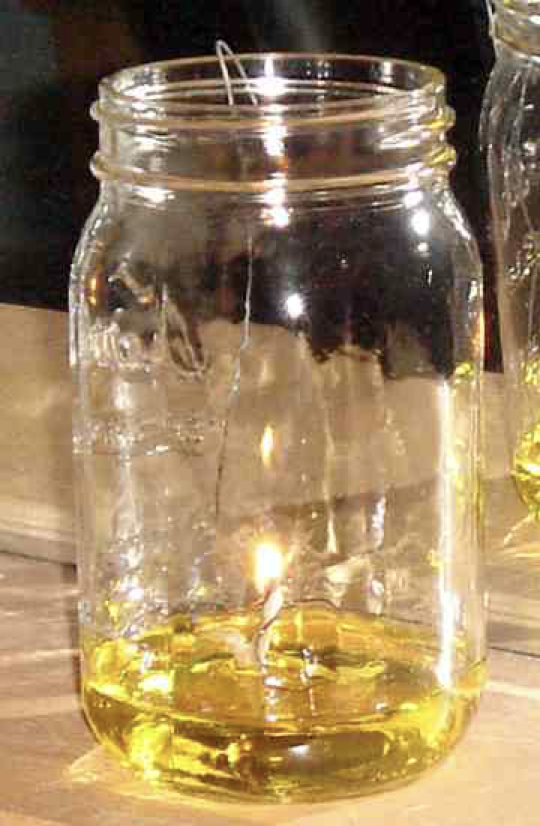
- Form one end of the wire into a long hook, about the same height as the jar (it holds the wire on the jar and doubles as a handle to pull the wick up for lighting).
- Wrap the other end of the wire into a coil, creating a wick stand about an inch or two tall that sits on the bottom of the jar.
- Thread about 2 inches of the salted wick up through the coil so that about a quarter inch or less of the wick is sticking up above the wire coil (any longer and the wick will smoke). The longer end of the wick will be soaking in the olive oil.
- Add enough olive oil to your jar so that the level is just under where the wick is pinched by the wire. Any higher and you risk putting out the lamp with the oil.

By using a canning jar, you can close the jar for storage with a canning lid, when the lamp is not in use. Various sizes of jars will work just fine by adjusting the size of the wick holder to fit the size of the jar. And author Duke used a canning jar lid with a hole punched in it to hold the wick instead of a wire coil to ensure the oil didn’t spill.
Also, any (non-plastic) container can be turned into an oil lamp. Shoot, you can even use the bottle your olive oil came in! In ancient times empty sea shells or even rocks with a slight indentation were used for this purpose. And actually, any natural fiber can be used as a wick.

The lamp works by drawing the olive oil up the wick, where it vaporizes and gets burned by the flame. A few ounces of oil will burn for several hours, making it less expensive than most candles. And if you have problems with it smoking when blowing it out, use wet fingers to put out the flame, or just douse it with the oil in the jar.
If you’d like to fancy things up, you can infuse your olive oil with herbs, spices, essential oils, or citrus slices for a more scented experience.

And speaking of fancy, another clever person created an olive oil lamp chandelier out of a discarded lamp shade frame. I didn’t find instructions on how to secure the jars to the shade base, but I bet we could figure it out!
Finally, you might want to get the little book, BOOK 2: OLIVE OIL LAMPS & ETC. (The Non-Electric Lighting Series) by Ron Brown. I found it on amazon.com for about $7. Besides olive oil, Brown also explains how to use other food grade oils, cotton puffs, and so on (which is why ETC is in his title).

The olive oil lamp has been around since Biblical times. Think of it as proven technology. Emergency lighting from your kitchen—who knew?
Sources:
- www.lehmans.com
- www.todayifoundout.com
- www.craftingagreenworld.com
- www.m.outdoorrevival.com
- www.pinterest.com
- www.thekinnardhomestead.com
- www.luchnos.com
 Alice Osborne
Alice Osborne
Weekly Newsletter Contributor since 2006
Email the author! alice@dvo.com
